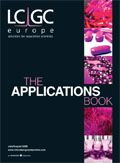Fast Analysis of Tobacco Nitrosamines in Cigarettes by LC–MS–MS
Tobacco specific nitrosamines (TSNA) are a group of carcinogens found only in tobacco products and are formed from nicotine and related alkaloids during the production and processing of tobacco and tobacco products.
Leo (Jinyuan) Wang and William C. Schnute, Dionex Corporation, Sunnyvale, California, USA.
Tobacco specific nitrosamines (TSNA) are a group of carcinogens found only in tobacco products and are formed from nicotine and related alkaloids during the production and processing of tobacco and tobacco products.1 As a result of their carcinogenic properties, efforts have been made to reduce TSNA levels in tobacco products. The project goal was to demonstrate a high throughput and sensitive method to monitor TSNA levels.
Conventional methods for TSNA analysis are based on gas chromatography with thermo energy analyser (GC–TEA)2,3 or high performance liquid chromatography (HPLC) with various detection techniques, such as UV and mass spectrometry (MS).4–6 This application note describes a robust and fast LC–MS–MS method for the determination of four TSNAs in tobacco cigarettes.

Mass spectrometric conditions
See Figure 1.

Method Performance
Figure 1 shows the four TSNAs retained and completely resolved within 3.5 min, with the minimum of the retention factors (K'NNN) being greater than four and minimum resolution (RsNAT) greater than two. Demonstrated retention factors ensure the chromatographic separation of analytes of interest from early eluted compounds, which minimizes the possibility of ionization suppression and eliminates cross contamination of SRM transitions between main analytes. The use of specific MS–MS detection allows the simplification of sample preparation and the greater sensitivity ensures quantification confidence at low levels.

Figure 1
Because the analytical column was running under the very harsh conditions of high temperature and high pH mobile phase, method ruggedness was evaluated by repeated injections of standard solutions and tobacco extracts and was well maintained after more than 1000 injections.
Conclusion
A simple, sensitive and specific method for the determination of tobacco specific nitrosamines is demonstrated and has been applied to the analysis of TSNAs in different cigarettes.
References
1. S.S. Hecht and D. Hoffmann, Carcinogenesis, 9, 875–884 (1998).
2. J.D. Adams, K.D. Brunnemann and D. Hoffmann, J. Chromatog. A, 256, 347–351 (1983).
3. I.S. Krull et al., J. Chromatog. A, 260, 347–362 (1983).
4. W. Wu, D.L. Ashley and C.H. Watson, Anal. Chem., 75, 4827–4832 (2003).
5. K.A. Wagner et al., Anal. Chem., 77, 1001–1006 (2005).
6. J. Wu et al., Anal. Chem., 80, 1341–1345 (2008).
TSQ Quantum Access is a trademark of Thermo Fisher Scientific. All other trademarks are the property of Dionex Corporation.

Dionex Corporation
1228 Titan Way, PO Box 3603, Sunnyvale
California 94088-3603, USA
tel. +1 408 737 0700 fax +1 408 730 9403
Website: www.dionex.com

Characterizing Polyamides Using Reversed-Phase Liquid Chromatography
May 5th 2025Polyamides can be difficult to characterize, despite their use in various aspects of everyday life. Vrije Universiteit Amsterdam researchers hoped to address this using a reversed-phase liquid chromatography (RPLC)-based approach.
New Method Explored for the Detection of CECs in Crops Irrigated with Contaminated Water
April 30th 2025This new study presents a validated QuEChERS–LC-MS/MS method for detecting eight persistent, mobile, and toxic substances in escarole, tomatoes, and tomato leaves irrigated with contaminated water.
University of Tasmania Researchers Explore Haloacetic Acid Determiniation in Water with capLC–MS
April 29th 2025Haloacetic acid detection has become important when analyzing drinking and swimming pool water. University of Tasmania researchers have begun applying capillary liquid chromatography as a means of detecting these substances.
Prioritizing Non-Target Screening in LC–HRMS Environmental Sample Analysis
April 28th 2025When analyzing samples using liquid chromatography–high-resolution mass spectrometry, there are various ways the processes can be improved. Researchers created new methods for prioritizing these strategies.

.png&w=3840&q=75)

.png&w=3840&q=75)



.png&w=3840&q=75)



.png&w=3840&q=75)
















